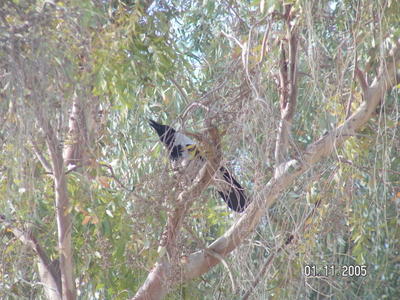
 Pond at Tallil Airbase (Ali Base) December 2004. The Ziggurat of Ur is in the distance. I watched a pair of Pied Kingfishers, a Kentish (Snowy) Plover, a Grey Heron and a fine Male Black Redstart here. The city of Ur was the traditional home of the prophet Abraham.
Pond at Tallil Airbase (Ali Base) December 2004. The Ziggurat of Ur is in the distance. I watched a pair of Pied Kingfishers, a Kentish (Snowy) Plover, a Grey Heron and a fine Male Black Redstart here. The city of Ur was the traditional home of the prophet Abraham.Though this blog is focused on Iraqi wildlife I will make a little detour on this entry.
A reader soon to deploy to Afghanistan asked a few questions that I'll try to answer here.
The first is: what resources are there on Afghan birds? I've only found a few references since Afghanistan has been somewhat neglected since the 1979 Russian invasion. A few old British texts describe the wildlife of the region. Birdlife international has a review of the birdlife of Afghanistan which has a mix of palearctic and oriental species and 460 recorded species. There is one Afghan endemic, Afghan Snowfinch (Montifringila theresae). Happily we have one recent trip report of 82 species made by Anssi Kullberg combining the observation of 4 trips through Afghanistan in 2002. Some spectacular birds are to be seen. A birder from Iraq would recognise many of the familiar favorites: Magpies, Hoopoes, Crested Larks, Pied Kingfishers, Indian and European Roller plus many others. They would also be treated to birds of Indian origin like Brahminy Starling, Black Drongo and House Crow. Some truly exotic birds like the Himalayan Monal, a colorful and rare pheasant, are also on the Afghan list. A somewhat pricey two volume guide has been published this year by Lynx in Spain. The Birds of South Asia is the first guide to fully cover the birds of Afghanistan and at slightly less than $100 US is a good investment for someone spending a long time in Afghanistan.
Another question involved digiscoping and blogging from a forward deployed area. Others may want to add their 2 cents here. I did not have a great camera for birds, nor a scope. If I had to do it again I would try to bring both. I missed a lot of birds because they were out of binocular range.
I found that blogging anonymously is the way to go. It simplifies things considerably and makes the command much more comfortable with your blogging in general. My self imposed rules were very strict because of my role in battalion intelligence. I never revealed my name, my unit or my location in the country. We had many incidents that I never wrote about on my other blog because a relatively smart person could identify my location from the incident and perhaps use it for battle damage assessment. When it came to my wildlife watching, any and all my writing was seen as universally innocuous and not an operational security issue.
I've started posting again on HomeRange, my general natural history blog. It started out as my nature observations but I let it slide in back in May. I recently changed the focus to whatever I feel like writing about, from my observations to interesting news items.


